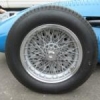What was the first ever motorsport event?
#1

Posted 07 May 2009 - 20:08
Advertisement
#2

Posted 07 May 2009 - 21:57
At least that's what the Guinness Book fo Car Facts And Feats states. I've never found another reference to it.
#3

Posted 07 May 2009 - 22:25
For a more conventional answer than ensign's one you could go to sites by different TNF members; Dennis David, Leif Snellman, and Quintin Cloud. If I've done the links right with the new software that is.
#4

Posted 07 October 2019 - 09:54
Since the earlier days of the TNF it seems 'accepted knowledge' here, that the first true motor race happened as one among other competitions of this 'Wisconsin Reliability Trial'. Now I am very surprised to read a short article at unraced f1, suggesting that the very first such contest would have been in fact taken place at Manchester in 1867, even with a photograph! Even more to my surprise is, that I can not find any mention of that event in this forum!
So how reliable is this information? Unraced f1 is relying on another text on anarchdia.blogspot.com with a bit more background information. Among other it mentions two references, William Fletcher: The History and Development of Steam Locomotion on Common Roads and Arthur Rosling Bennett, The Chronicles of Boulton's Siding and also what would be the original source, a report of the event in The Engineer of 30th August, 1867. So do we have to re-write history (again)?
#5

Posted 07 October 2019 - 14:36
While researching the history of 24 Hour races I found this resource - it may prove useful.
http://www.dlg.speed.../book/book.html
#6

Posted 07 October 2019 - 17:53
While researching the history of 24 Hour races I found this resource - it may prove useful.
Compiled by Darren Galpin of this parish ...
#7

Posted 07 October 2019 - 18:45
A delve into the archives of The Manchester Guardian brings up the following.
On August 23rd 1867, the paper published a letter from Thomas Boulton, who claimed to have made a 90-mile round trip on one of his company's steam road locomotives, starting and finishing at Ashton-Under-Lyne. 'Monday last' would have been August 20th.

As the letter says, there was to be an agricultural show at Old Trafford a few days later. Known as the Implement Show it was organised by the Liverpool and Manchester Agricultural Society. Here's the relevant part of the same paper's report, i/d August 27th.
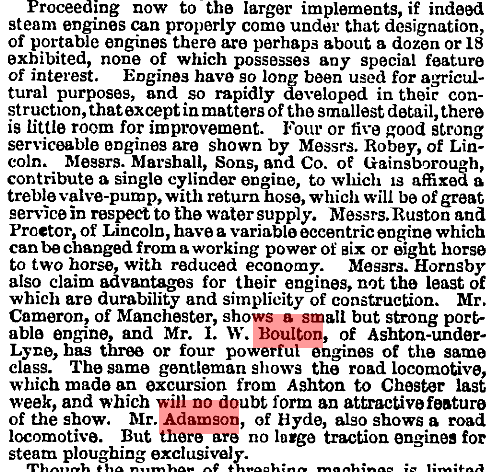
So, we have the classic 'the first race happened when the first two vehicles met'! There is however - as far as I can tell - no mention of any contest between the two machines. That's not to say one didn't happen of course and it's perhaps worth noting that on September 19th the paper also reported the presence of a steam traction engine on Manchester's streets, mentioning that it had travelled at an average of 5 mph - 'a greater speed not being admissible ...'
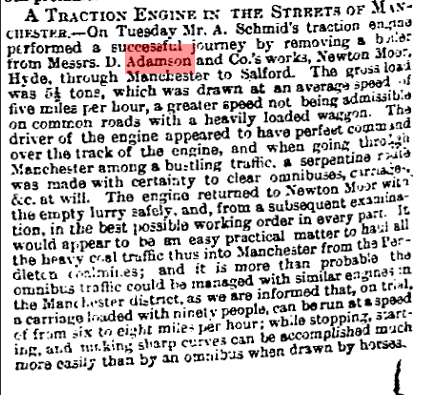
So perhaps there may be more to find in the local papers of the day?
#8

Posted 07 October 2019 - 20:31
That´s very interesting stuff! So we have also probably the very first 'speed week' here ![]()
Together with the report from "The Engineer" (which for purpose of completion I will quote here) the picture gets gradually clearer now:
“A NOVEL RACE. – On Monday morning, the 26th instant, in accordance with previous arrangement, two road steam carriages, one made by Mr. Isaac W. Boulton, of Ashton-under-Lyne, having only one 4¼ in. cylinder 9 in. stroke, the other, made by Messrs. Daniel Adamson and Co., of Newton Moor, having two cylinders 6 in. diameter, 10 in. stroke, started from Ashton-under-Lyne at 4.30 a.m. for the show ground at Old Trafford, a distance of over eight miles. The larger engine, made by Messrs. Adamson and Co., is a very well-constructed engine, and had a good quarter of a mile start of the smaller machine. The little one, with five passengers upon it, passed the other in the first mile, and kept a good lead of it all the way, arriving at Old Trafford under the hour, having to go steady through Manchester. The engine made by Mr. Boulton ran the first four miles in sixteen minutes. The running of both engines is considered very good. On arrival at Old Trafford they tested their turning qualities, and both engines turned complete circles of 27ft. diameter, both to right and left, frequently.”
So we have confirmation now that indeed there was an exhibtion of such vehicles at Old Trafford that week and that Boulton´s as well as Adamson´s machines were participating. As Boulton was from Ashton and - as I understand - Adamson from Dukinfield - two towns close to each other on the opposite banks of the Tame river - and with a look at the map it gets clear, that if both had made 'previous arrangement' to drive their vehicles to Trafford on the same day, to turn this into a 'contest' was more or less inevitable...
That could also explain the 'good quarter of a mile start' in the report for Adamson´s machine, as maybe they would not have gathered on a common 'starting line', but instead could have set off from their own company grounds each. All in all it sounds indeed not like an official competition, as otherwise other locomobiles from the Old Traffoird show could have joined in, but rather a 'private' meeting instead, maybe a 'promotion tour' of the two companies to attract attention for their two machines at the exhibition.
So, we have the classic 'the first race happened when the first two vehicles met'!
So isn´t it nice that, at last, it seems that there is a confirming example to this old proverb...
Edited by uechtel, 07 October 2019 - 20:33.
#9

Posted 07 October 2019 - 22:02
From the Manchester Weekly Times, August 31st 1867, again reporting on the agricultural show. 'Something like a race ...'

#10

Posted 07 October 2019 - 22:18
I also found two identical reports in the August 28th issues of the Leeds Mercury and the London Daily News, both of which mention that the machines were capable of 'upwards of 10 mph'.
I wonder if the mention of a quarter of a mile start perhaps indicates that the Boulton machine was somewhat reticent to get going, having not built up quite a sufficient head of steam?
#11

Posted 08 October 2019 - 02:20
Automotive contests from the latter part of the 19th and early years of the 20th centuries tend to be overlooked or simply ignored. Relatively little recent work has been focused upon this period. The Manchester event certainly looks interesting and an example of what might be lurking out there. It certainly merits the attention it seems to be attracting. The Wisconsin trials did include a contest that matched the machines to a head-to-head test on a mile track, but this information on the Manchester machines is really fascinating.
As soon as things settle down, I am returning to my research into this era, focusing on the North American side of the Atlantic. In recent weeks, I have found much of interest in the bicycling journals that I have finally begun to comb through. It is interesting that the influences on American motor sport during the first decade or so came as much from bicycle racing as it did from horse racing, perhaps even more so as I dig and sort things out. I thought I had a decent handle on bicycling sport in the USA, but I have been somewhat disabused of that notion as I read more regarding the rather fascinating politics of the sport.
If nothing else, the cycling journals have help fill in some of the gaps of the late-1890s and early-1900s that I had pondered.
#12

Posted 08 October 2019 - 08:46
I wonder if the mention of a quarter of a mile start perhaps indicates that the Boulton machine was somewhat reticent to get going, having not built up quite a sufficient head of steam?
Or perhaps that handicap racing is as old as the racing itself! ![]()
#13

Posted 08 October 2019 - 10:07
Boulton's letter about his trip to Chester also appeared in the August 24th issue of the Cheshire Observer.
From The Ashton Weekly Reporter, and Stalybridge and Dukinfield Chronicle, also the August 24th issue, and obviously a paraphrase of the letter, but with additional details presumably provided by Boulton in person:
Travelling by Steam on the Highway. — On Monday last Mr. Thomas Boulton ran a small Lees road engine, constructed by Mr.Thomas Boulton, of this town, from Ashton, through Manchester, Eccles, Warrington, and Preston Brqok to Chester. The engine went through the principal streets of the ancient city and returned to Ashton, a distance of 90 miles in one day, without a single mishap or stoppage of any kind, except to take in water. We have reason to think that this is the largest continuous run on record having been accomplished by any Road Lees Engine, within the 24 hours. The engine has only one 4½ inch cylinder, 9 inch stroke, 13 lbs. pressure, and 5 feet wheel. It carried six persons the greater part of the distance, and in some places eight and ten were upon it. When it is taken into consideration that 80 miles of the road was perfectly strange to all concerned, and required a sharp look out for water the journey becomes more remarkable. — On Saturday last the same engine ran from the Star Inn, Oldham, to Ashton with ten passengers in half an hour, and the previous Saturday it ran to Glossop and back.
The Star Inn was situated at 49 King Street, Oldham. It opened in 1833, closed in 2005 and is now a fried chicken shop. The road used was presumably what is now the A627 - almost dead straight (turnpiked?) - and the distance approximately five miles, so another 10mph run. Ashton to Glossop is about eight miles each way.
Ibid, August 31st.
On Monday morning last, in accordance with previous arrangements, two road steam carriages, one made by Messrs. Daniel Adamson and Co., Newton Moor, having two 6 inch cylinders, 10 inch stroke, and the other made by Mr. Isaac W. Boulton, of this town, having only one 4½ inch cylinder, 9 inch stroke, started from Ashton-under-Lyne at 4.30 a.m., for the Manchester and Liverpool show ground at Old Trafford, a distance of over eight miles. The larger engine, made by Messrs. Adamson and Co., is very well constructed, and had a good quarter of mile start of the small engine. The little one, with five passengers upon it, passed the other in the first mile, and kept good lead of it all the way, arriving Old Trafford under the hour (having to go straight through Manchester). The engine made by Mr. Boulton ran the first four miles in sixteen minutes. The running of both engines is considered very good. On arriving at Old Trafford they tested their turning qualities, and both engines turned complete circles of 27 feet diameter, both to right and left frequently.
Some minor discrepancies from The Engineer's report, but it does appear that we have a pre-arranged match race here.
#14

Posted 08 October 2019 - 13:46
Automotive contests from the latter part of the 19th and early years of the 20th centuries tend to be overlooked or simply ignored. Relatively little recent work has been focused upon this period. The Manchester event certainly looks interesting and an example of what might be lurking out there. It certainly merits the attention it seems to be attracting. The Wisconsin trials did include a contest that matched the machines to a head-to-head test on a mile track, but this information on the Manchester machines is really fascinating.
As soon as things settle down, I am returning to my research into this era, focusing on the North American side of the Atlantic. In recent weeks, I have found much of interest in the bicycling journals that I have finally begun to comb through. It is interesting that the influences on American motor sport during the first decade or so came as much from bicycle racing as it did from horse racing, perhaps even more so as I dig and sort things out. I thought I had a decent handle on bicycling sport in the USA, but I have been somewhat disabused of that notion as I read more regarding the rather fascinating politics of the sport.
If nothing else, the cycling journals have help fill in some of the gaps of the late-1890s and early-1900s that I had pondered.
In this point I agree very much. To me the Manchester "race" as well as the Wisconsin trial seem to be singular events without any effect on motor racing. The machines participating were clearly not designed for "speeding", which was at most only one minor aspect among other much more important cirteria (load, reliability, consumption, handling etc.). The real "spirit" of racing in my opinion would have come from cycling, which - at the time - had been the most fancy "machinery" before the introduction of motorized vehicles, and was already established as "sport" with its own racing culture, which then indeed seems to have strongly affected on the early motoring events. For example the the early town-to-town-races in the 1890ies I think were combined with cycling events, sometimes cars, motorbikes, bi- and tricycles even competing each other directly. And not to forget, cycling is regarded to be the first sporting dicipline to have introduced professional sponsoring and 'works teams' and many bicycle companies soon also started automobile production.
In contrast to that, to me "classic" horse races are always connected to race tracks, so maybe this is already a foundation for the different directions of "American style" track racing and "European style" road racing? How popular were bicycle races in the US (on road or track?) and had there been also "classic" long distance events (like Paris-Rouen etc.) for horses?
#15

Posted 08 October 2019 - 14:24
There had been point-to-point horse racing, still indeed exists, but in Britain at least the racecourses were always a bigger thing - after all you could charge for admission, and, more crucially, betting was allowed there. Hence Brooklands being basically a concrete Ascot.
#16

Posted 08 October 2019 - 16:04
I'd always assumed there was a natural progression from bicycles to automobiles. What is a bicycle but a mechanical device for travelling without horse or oxen? Early car enthusiasts such as S.F Edge and Charles Jarrott were keen cyclists first. Meanwhile, bicycle manufacturers such as Darracq, Humber and Ceirano (the core of FIAT) turned to the production of cars.
#17

Posted 08 October 2019 - 17:17
The machines participating were clearly not designed for "speeding", which was at most only one minor aspect among other much more important cirteria (load, reliability, consumption, handling etc.).
Although right from the beginning of the sport the manufacturers have often stressed that 'racing improves the breed'. ![]()
#18

Posted 08 October 2019 - 18:12
Hence Brooklands being basically a concrete Ascot.
Or a track-cycling velodrome, on a larger scale.
#19

Posted 09 October 2019 - 01:53
In contrast to that, to me "classic" horse races are always connected to race tracks, so maybe this is already a foundation for the different directions of "American style" track racing and "European style" road racing? How popular were bicycle races in the US (on road or track?) and had there been also "classic" long distance events (like Paris-Rouen etc.) for horses?
Interest in bicycle racing in the USA from about the mid-1880s until somewhere around the end of the first decade of the 20th century was during most of this period, Huge. This is not an exaggeration. Bicycle racers such as Eddie Bald and Major Taylor and others (Tom Cooper, Barney Oldfield) were as popular as baseball players. The events of the LAW (League of American Wheelmen) were on tracks, some specially-built velodromes and others on existing tracks used for horse racing events (thoroughbred or harness), which should sound familiar... There was road racing in bicycle racing, ranging from hill climbs to sprints on closed roads to century events to point-to-point events. Although the LAW is generally the best-known of the cycling organizations, it was not the only one, there being several others, especially during the 1890s when there was a schism within the sport regarding the topics of professionalism, event venues (the issue of road racing vs. track events), and the usual squabbles that seem inherent to American sport.
I think and would suggest that Uechtel is correct regarding the nature of the Manchester and Wisconsin events as being singular events, in that they did not serve as catalysts for steam road engine racing, whether on the road on on the track. Not until the mid-1890s did contests for "motor cycles" or "automobiles" emerge and subsequently lead to where we are today (wherever that might be...). The very variety and nature of the automotive contests of the first decade or so of the sport tends to lead many to either discount them as "racing" events and, therefore, ignore them. However, the contemporary interest in endurance events, trials, and tours was very high, something that Darren Galpin clearly grasped in his research, as have others since then.
The interest, research, and work on the North American automotive contests during the formative years certainly seems to be far less than that shown towards those in Europe during the same period. I feel that one of the major reasons that my lack of interest regarding the early decades of American was matched only by my lack of knowledge of the same was largely due to the dearth of material that might be generally available compared to that focused on Europe during this timeframe. Fortunately, over the past decade or so there have emerged research materials that should benefit those brave souls venturing into this topic.
Advertisement
#20

Posted 09 October 2019 - 09:12
I'd always assumed there was a natural progression from bicycles to automobiles. What is a bicycle but a mechanical device for travelling without horse or oxen?
To me, I think even more. Wasn´t the bicycle the very first technology to overcome the "speed limitation" set by nature for individual transport? Ok, there had been sailing boats, steamships and also steam locomotives had already reached crazy speeds, but all this required a comparatively big 'effort' (rails, crews, logistics, material, production...) and was not really 'individual'. For a single person, to get from one point to another, it had been possible only to travel as fast as feet (yours or or those of an animal) would carry you or as the blow of the wind at the very moment. So when the bicycle became available, it must have been a fascinating imagination at the time to be 'faster than the wind' by your own means.
Edited by uechtel, 09 October 2019 - 09:13.
#21

Posted 09 October 2019 - 12:00
Often overlooked for some reason, the Good Roads Movement in the United States was an initiative of the cycling movement, started well before the automobile appeared upon the scene. In addition, the bicycle received great support from those within the public health community, especially in urban areas, thanks to helping reduce the number of horses needed for personal transport (consider for a moment the amount of horse urine and manure deposited on the streets of, say, New York or Boston or Charleston in a single day...), support which was then later transferred to the automobile. Plus, of course, the notion of individual mobility that the bicycle bestowed without the costs associated with the livery for a horse and storage for a carriage. It also affected the infrastructure costs for building the tracks for trolley systems. And so forth....
Racing automobiles in the United States really did not reach a launching point until about the period from late 1901 into the 1903 season. By the 1904 season, track racing was well-established, as were endurance events/reliability trials, hill climbs, and tours. Road racing did not emerge until the 1908 season, despite the popularity of the Vanderbilt Cup. Using public roads for tours or endurance runs was one thing, racing on them was another altogether different situation. This was due in no small part to the consequences of the crash of the Baker Torpedo on 31 May 1902 on Staten Island during speed trials sanctioned by the Automobile Club of America, with litigation dragging on for literally years. In the immediate aftermath of the event, the ACA forbade speed contests, especially races, on public roads. This was, incidentally, one of the factors that led W.K. Vanderbilt, Jr. to the AAA Racing Board and its sanctioning his cup events.
#22

Posted 09 October 2019 - 12:14
One thing to add to that is that the same people in early motoring were often the same people in early aviation. It might have looked the next logical step for personal transportation and sporting events. But, the former has proved too tough a nut, and the latter not easy to monetize...
#23

Posted 09 October 2019 - 15:59
Famous bicycle riders in 1895/96 (Jules Beau photos/Bibliothèque Nationale/Paris):
Henry Fournier (won Paris-Bordeaux and Paris-Berlin in 1901):
and Earl Kiser (early dirt track star):
#24

Posted 09 October 2019 - 19:31
The Locomotive Act, commonly known as the Red Flag Act, was passed in 1865 restricting self propelled road vehicles to 4 mph. Those early "racers" in 1867 Manchester were therefore breaking the law but were happy for the newspapers to write about it. Similarly the newspapers made no attempt to point it out. Curious!
#25

Posted 09 October 2019 - 20:05
The Locomotive Act, commonly known as the Red Flag Act, was passed in 1865 restricting self propelled road vehicles to 4 mph. Those early "racers" in 1867 Manchester were therefore breaking the law but were happy for the newspapers to write about it. Similarly the newspapers made no attempt to point it out. Curious!
My interpretation of The Manchester Guardian's comments is that they were quietly ridiculing the law in pointing out that Adamson's engine had averaged 5 mph - 'a greater speed not being admissible ...' The 1865 Act specifies a speed of just 2 mph in towns.
I'll have a hunt through and see if I can find any direct criticism of the Locomotives Act 1865 in the paper's pages.
#26

Posted 09 October 2019 - 20:37
No criticism that I can see, but this - from the August 26th 1865 issue - taught me something. It appears that boroughs with a population of over 5000 could set their own speed limit if they so wished, presumably by way of a bye-law. So perhaps the law was not as clear-cut as is usually portrayed. See the final sentence.
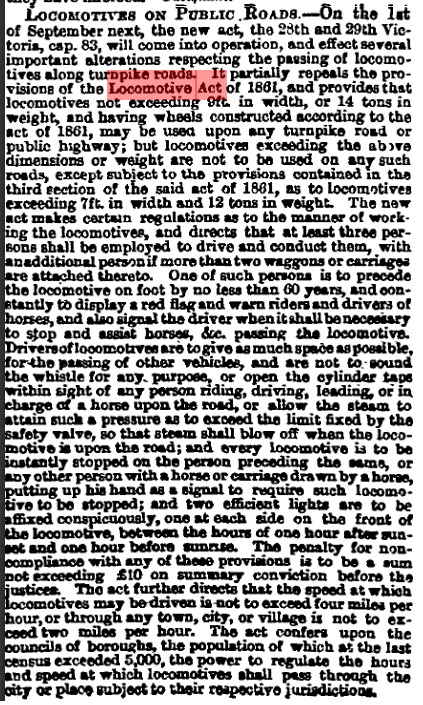
A 'go-ahead' borough like Manchester would surely not have wanted to be restricted by pettifogging speed limits which would merely disrupt the flow of commerce. You could go faster than that on a canal! So maybe there's something to be found on that in the city's archives? I also found three official notices in The Observer, confirming that the speed limit in London would be 2 mph.
There's also a very amusing typo in the above clipping. See if you can spot it. ![]()
#27

Posted 09 October 2019 - 22:14
#28

Posted 10 October 2019 - 08:01
My interpretation of The Manchester Guardian's comments is that they were quietly ridiculing the law in pointing out that Adamson's engine had averaged 5 mph - 'a greater speed not being admissible ...' The 1865 Act specifies a speed of just 2 mph in towns.
I'll have a hunt through and see if I can find any direct criticism of the Locomotives Act 1865 in the paper's pages.
The interesting question to me is, how was this law to be enforced? If a policeman comes in sight you can immediately slow down. If you were not completely exaggerating, how should he prove, that you were "speeding"?
"The little one, with five passengers upon it, passed the other in the first mile, and kept a good lead of it all the way, arriving at Old Trafford under the hour, having to go steady through Manchester. The engine made by Mr. Boulton ran the first four miles in sixteen minutes."
So the overall average speed must have been around 10 mph, with an average of 15 mph when out on the 'countryside' and an average of at least 5 mph for the second half of the distance when passing through the settled areas.
#29

Posted 10 October 2019 - 08:11
No criticism that I can see, but this - from the August 26th 1865 issue - taught me something. It appears that boroughs with a population of over 5000 could set their own speed limit if they so wished, presumably by way of a bye-law. So perhaps the law was not as clear-cut as is usually portrayed. See the final sentence.
A 'go-ahead' borough like Manchester would surely not have wanted to be restricted by pettifogging speed limits which would merely disrupt the flow of commerce. You could go faster than that on a canal! So maybe there's something to be found on that in the city's archives? I also found three official notices in The Observer, confirming that the speed limit in London would be 2 mph.
There's also a very amusing typo in the above clipping. See if you can spot it.
A very nice document. Unfortunately my English seems not firm enough to spot out the typo, but I understand the last sentence, that it did not override the 2mph speed limit, but was meant to allow towns to install further restrictions on top?
Also very surprisng to read of "turnpike roads" and "highways" and I wonder what had been the difference to normal roads or chaussees and what kind of traffic would have to be seen there.
#30

Posted 10 October 2019 - 08:24
A turnpike road would have been under the control of a Turnpike Trust - they undertook to improve or even build new roads with better surfaces, etc. In return they received tolls from users. A highway was a road not subject to tolls.
https://en.wikipedia...Turnpike_trusts
#31

Posted 10 October 2019 - 09:23
"An Early Motor Car", a steamer built between 1868 and 1870 and powered by a single cylinder of 5 x 7 inches - from The Automotor and Horseless Vehicle Journal, April 1897: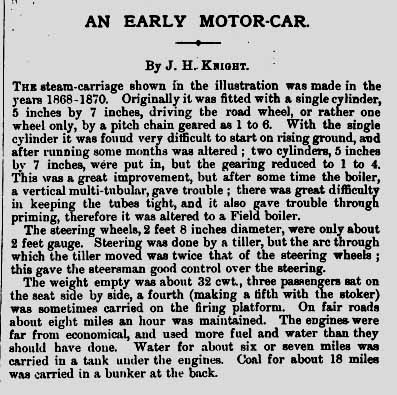
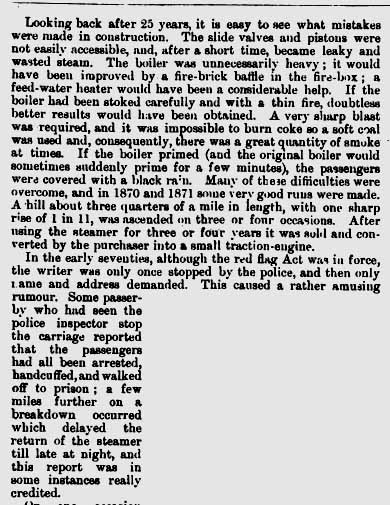
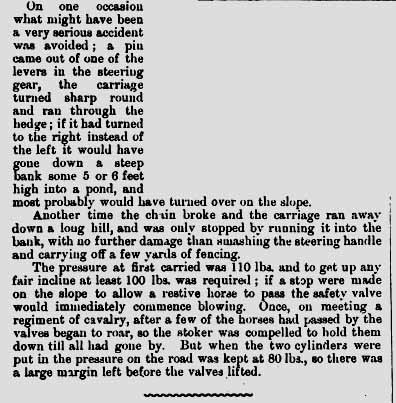
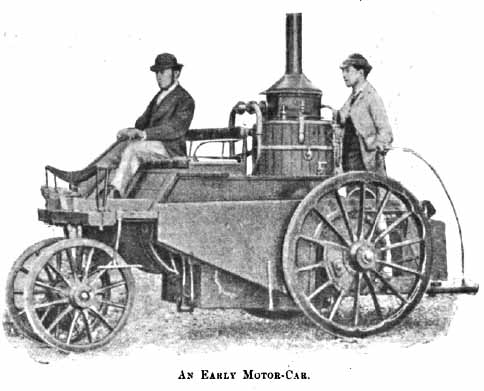
#32

Posted 10 October 2019 - 11:10
Got it! Proves how forward thinking the authorities were in trying to restrict motor vehicles?
#33

Posted 10 October 2019 - 11:23
I guess it wasn't that hard then...
#34

Posted 10 October 2019 - 11:40
Thank you Robert. Reading that, it would appear that the 'Red Flag Act' was perhaps 'honoured more in the breach than the observance' and that it might only have become an issue once those new-fangled internal combustion engines arrived on the scene in the early 1890s and the first motorists/automobilists/autocarists - who would never have dreamed of owning a steam road vehicle, but would have been rich and influential - started making noises against what they perceived as the iniquities of the law. After all, by the 1860s, horses and other livestock would have become very used to steam engines of all sorts - railway locomotives, traction engines, steamrollers and even steam trams. It makes me wonder how many prosecutions - successful or not - were brought under the Act?
It would of course have been very difficult (impossible?) for the average rural constable to judge the speed of a moving vehicle. Even in the early years of faster motor cars it was pretty much 'hit and miss', with speed traps being set up on straight sections of road - usually a quarter-mile - and speed calculated manually using a stopwatch, a process which required at least two officers; one to signal and one to time. More officers were presumably needed to actually stop the 'miscreants'.
Got it! Proves how forward thinking the authorities were in trying to restrict motor vehicles?
Either that or time travel has been perfected some time in the future. Or the past. ![]()
#35

Posted 10 October 2019 - 11:43
Hence my earlier post.
#36

Posted 11 October 2019 - 11:40
It appears that councils did indeed have powers to vary the provisions of the Act. I've found references to this in Leeds - unspecified changes to the permitted hours from August 1870 and unspecifed amendments connected to the Leeds Tramways Act 1876; London - steamrollers only were allowed to be operated 24 hours a day from November 1870; Lowestoft - complicated bye-laws related to the hauling of fish from the docks to the main line station in 1872; Cardiff - steam road vehicles permitted 24 hours from 1876; Hull - strict limits on permitted times and a maximum speed of one mph, 1878 ....
The first court report I've found is from 1876 in Oxfordshire - more than 10 years after the Act - for not displaying lights at night, not having a man with a red flag, causing a horse-drawn carriage to have to back up 30 yards (and frightening the lady passenger! An attack of the vapours, one might assume!) and the next in 1881 in Worcestershire - for not stopping when signalled to do so by the driver of a horse-drawn carriage and (again) no man with a red flag. Nothing else until 1886 in Portsmouth - no lights, no owner's name on the vehicle. As yet, I haven't found a single court report of a motorist being prosecuted under the Locomotives Act 1865!
#37

Posted 11 October 2019 - 11:49
... causing a horse-drawn carriage to have to back up 30 yards (and frightening the lady passenger! An attack of the vapours, one might assume!) ...
How much could you reverse a horse-drawn carriage? Were the harnesses designed for a couple of minutes of awkward back load?
#39

Posted 11 October 2019 - 12:49
Surely it's easy to back a horse. William Hill makes a living off that.
Advertisement
#40

Posted 11 October 2019 - 13:04
It can be done:
https://youtu.be/4T2VYN6ddXk
He clipped one of the markers so Minus 5 points. In the daylight, using a cart with over the shoulder vision. I think the dog agrees with me: Ruff
#41

Posted 11 October 2019 - 16:11
Surely it's easy to back a horse. William Hill makes a living off that.
If only there were a "Groan" button.
#42

Posted 12 October 2019 - 13:26
How much could you reverse a horse-drawn carriage? Were the harnesses designed for a couple of minutes of awkward back load?
Since downhill work relies on the horse(s) holding the carriage in check, the harness could cope with a degree of load reversal.






